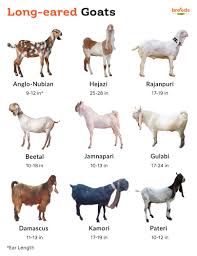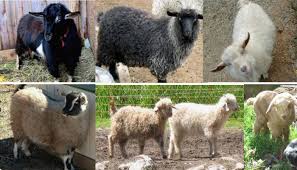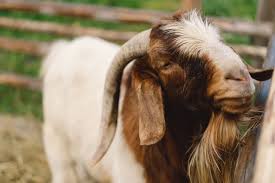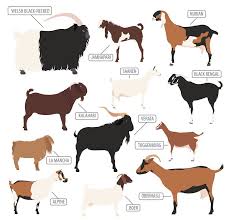Breeds of Goats encompass a diverse range of species, each with unique characteristics, purposes, and adaptations. Goats are among the oldest domesticated animals, with a history spanning thousands of years. They have been invaluable to human society, providing milk, meat, fiber, and skins. As a result of their long-standing relationship with humans, various breeds have emerged, tailored to specific climates, environments, and agricultural needs.
Goats can be broadly categorized into two main types: dairy goats and meat goats. Dairy breeds, such as the Saanen, Nubian, and Alpine, are prized for their milk production. These breeds are known for their high yields and rich, creamy milk, which can be processed into cheese, yogurt, and other dairy products. Saanen goats, originating from Switzerland, are particularly renowned for their large milk output and calm temperament.
Nubians, with their distinctive long ears and varied color patterns, are favored for their flavorful milk and adaptability to different environments. Alpine goats, also from the mountainous regions of Europe, are hardy animals that thrive in various climates and are celebrated for their excellent milk production.
On the other hand, meat goats, like the Boer and Kiko breeds, have gained popularity for their efficient growth rates and tender meat. Boer goats, hailing from South Africa, are recognized for their muscular build and rapid weight gain, making them a preferred choice among meat producers. Kiko goats, originally developed in New Zealand, are known for their resilience and ability to thrive on rough terrain while maintaining good body condition, which enhances their meat quality.
Fiber-producing breeds, such as the Angora and Cashmere goats, contribute significantly to the textile industry. Angora goats are prized for their luxurious mohair, which is soft and silky, making it ideal for high-quality garments.
Cashmere goats, on the other hand, produce a fine, soft undercoat that is highly sought after for its warmth and softness, often used in luxurious sweaters and shawls. Both breeds require specific care and management practices to ensure optimal fiber production, including regular shearing and proper nutrition.
In addition to their economic benefits, goats play a vital role in sustainable agriculture and land management. Their natural browsing behavior allows them to consume weeds, brush, and undergrowth, effectively helping to clear land and promote healthier ecosystems. This characteristic has led to the use of goats in controlled grazing practices, where they can assist in pasture management and reduce fire hazards in certain regions.
Understanding the various breeds of goats is essential for farmers and ranchers looking to optimize their production systems. Each breed’s specific traits and care requirements will influence the decision on which type to raise, depending on the intended purpose—be it milk, meat, fiber, or land management.
Moreover, as consumer preferences shift towards sustainable and ethically sourced products, the demand for various goat breeds continues to grow, making them an integral part of modern agriculture.
Classification of Goat Breeds: Understanding Different Types

Goats are versatile animals with various breeds classified based on their primary purpose, such as dairy production, meat production, and fiber production. Understanding these classifications helps farmers and breeders choose the right breeds for their needs.
Dairy Goat Breeds
Dairy goats are specifically bred for their milk production. They are known for their high milk yields and quality.
1. Saanen: A popular breed known for high milk production, Saanens are large, white goats with a calm temperament.
2. Nubian: Recognized for their distinctive long ears and a variety of colors, Nubians produce rich, creamy milk and have a friendly disposition.
3. Alpine: These goats are medium to large-sized, hardy, and adaptable, producing a good amount of milk with a pleasant flavor.
4. Toggenburg: This breed is known for its excellent milk quality and has a unique brown coat with white markings. They are also very resilient.
5. LaMancha: Famous for their short ears, LaManchas are friendly goats that provide a substantial amount of milk, making them a favorite among dairy farmers.
Meat Goat Breeds
Meat goats are bred primarily for their meat, which is lean and flavorful.
1. Boer: Originally from South Africa, Boer goats are well-known for their rapid growth and high-quality meat. They are characterized by their white body and brown head.
2. Kiko: Kiko goats are hardy, with good foraging ability and fast growth rates. They are well-suited for meat production in various climates.
3. Spanish Goat: This breed is known for its resilience and adaptability. Spanish goats are good foragers and produce lean meat, making them ideal for pasture-based systems.
4. Myotonic (Fainting Goat): Known for their unique fainting behavior when startled, Myotonic goats produce lean meat and are popular in niche markets.
5. Nubian: Although primarily a dairy breed, Nubians are also raised for meat due to their good body size and muscle development.
Read Also: 7 Medicinal Health Benefits of Daffodils (Narcissus Plant)
Fiber Goat Breeds

Fiber goats are raised for their fiber, which can be spun into yarn and used for various textile products.
1. Angora: Angora goats are famous for producing mohair, a luxurious fiber known for its sheen and durability. They require specific care to maintain their fleece quality.
2. Cashmere: Cashmere goats produce fine, soft fiber known as cashmere, which is highly valued for clothing. These goats are typically small and hardy.
3. Pygora: A cross between Pygmy and Angora goats, Pygoras produce both meat and fiber. Their fleece can vary in texture and is often used for specialty yarns.
4. Nigerian Dwarf: These small goats are not only great pets but also produce high-quality dairy and fiber. They come in various colors and have a friendly demeanor.
5. Saanen: While primarily known as a dairy breed, Saanens can also be raised for fiber production due to their thick, soft coats.
Dual-Purpose Goat Breeds
Dual-purpose goat breeds are those that are raised for both milk and meat production, offering versatility for farmers.
1. Nigerian Dwarf: This small breed is known for its high milk production relative to its size and good meat quality. They are friendly and adaptable, making them excellent for small farms.
2. Boer/Nubian Cross: Crossing Boer goats with Nubians combines the meat quality of Boer goats with the rich milk production of Nubians, creating a breed that excels in both areas.
3. Kiko: While primarily known for meat production, Kiko goats also produce a reasonable amount of milk, making them a viable dual-purpose option. They are hardy and adaptable to various environments.
4. LaMancha: Known for their unique ear structure, LaManchas are primarily dairy goats but also have a good body structure for meat production, making them dual-purpose.
5. Saanen: Though mainly recognized as a dairy breed, Saanens can provide decent meat yields due to their size and muscle structure.
Popular Goat Breeds Around the World
Goats are found in many cultures and countries, with various breeds recognized for their unique traits.
1. Boer: Originating from South Africa, Boer goats are known for their fast growth and high-quality meat, making them one of the most popular meat breeds globally.
2. Nubian: Known for their distinctive long ears and high milk quality, Nubians are popular in both the United States and the UK, cherished for their friendly temperament.
3. Saanen: As one of the most common dairy breeds, Saanens are recognized worldwide for their high milk production and gentle nature.
4. Angora: Famous for producing luxurious mohair, Angora goats are primarily raised for fiber in countries like Turkey and the United States.
5. Kiko: This breed, originally from New Zealand, is gaining popularity for its hardiness and meat quality, making it a favorite among commercial goat farmers.
Physical Characteristics of Goat Breeds
Goat breeds exhibit a wide range of physical traits, influenced by their breeding and purpose.
1. Size: Goats can vary in size, from small breeds like the Nigerian Dwarf to large breeds like the Boer. Size often correlates with their purpose; larger breeds tend to be better for meat, while smaller breeds may excel in dairy production.
2. Coat Type: Goat coats can be short, long, or curly. For example, Angora goats have long, curly hair, while Nubians have a short, smooth coat. The coat type can affect their adaptability to different climates.
3. Color: Goats come in various colors and patterns. Some breeds, like the Boer, are usually white with a brown head, while others like Nubians exhibit a range of colors.
4. Ear Structure: Ear shape varies among breeds. For example, LaMancha goats are known for their very short ears, while Nubians have long, floppy ears.
5. Body Structure: The body structure varies significantly based on the breed’s purpose. Dairy goats generally have a more angular frame, while meat goats tend to be stockier with more muscle mass.
Read Also: Pests of Stored Products and Damages Caused
Adaptability of Different Goat Breeds

Different goat breeds have varying levels of adaptability to their environments, which is crucial for successful farming.
1. Hardiness: Some breeds, like Kiko and Boer, are known for their hardiness and can thrive in various climates, making them suitable for diverse farming conditions.
2. Foraging Ability: Breeds like the Spanish goat are excellent foragers, allowing them to thrive in areas with limited resources and making them ideal for pasture-based systems.
3. Resistance to Diseases: Certain breeds have been bred for disease resistance, which can enhance their adaptability. For instance, the Boer goat is known for its resilience to various diseases and parasites.
4. Environmental Adaptation: Some breeds are more suited to specific climates. For example, Nubians do well in hot climates due to their origins, while other breeds may be better suited to cooler environments.
5. Behavior: The temperament of different breeds can affect their adaptability. Breeds that are more social and friendly, like the Nigerian Dwarf, tend to adapt better to herding and cooperative farming environments.
Choosing the Right Goat Breed for Farming
Selecting the right goat breed depends on various factors, including your farming goals, climate, and available resources.
1. Purpose of Farming: Decide whether you want goats for milk, meat, fiber, or a combination. For example, if you’re focused on dairy production, consider breeds like Saanen or Nubian. For meat, Boer or Kiko goats are excellent choices.
2. Climate Adaptability: Some breeds are better suited for specific climates. For instance, Nubians thrive in hot weather, while Alpine goats can handle cooler temperatures. Assess your local climate to ensure your chosen breed can adapt.
3. Size and Space: Consider how much space you have available. Smaller breeds, like Nigerian Dwarfs, require less space and are ideal for small farms. Larger breeds need more room to roam and graze.
4. Breed Availability: Research the availability of different breeds in your region. Some breeds may be more accessible than others, affecting your choice.
5. Personal Preference: Finally, consider your personal preference and experience. Some breeds are known for their friendly and easygoing nature, making them suitable for novice farmers.
Common Health Issues in Goat Breeds
Goats can be prone to various health issues, and being aware of these can help you maintain their well-being.
1. Parasites: Internal parasites, such as worms, are common in goats and can lead to anemia and weight loss. Regular deworming and pasture management are essential for prevention.
2. Foot Rot: This bacterial infection affects the hooves of goats, causing pain and lameness. Keeping hooves trimmed and maintaining dry, clean living conditions can help prevent foot rot.
3. Mastitis: Dairy goats are particularly susceptible to mastitis, an infection of the udder. Regular milking practices and hygiene can reduce the risk of this condition.
4. Nutritional Deficiencies: Goats require a balanced diet. Deficiencies in essential nutrients like calcium and phosphorus can lead to health issues, so providing a complete feed or supplements is vital.
5. Respiratory Issues: Goats can develop respiratory problems, especially in damp or poorly ventilated conditions. Ensuring proper housing and ventilation helps reduce the risk of respiratory diseases.
Caring for Different Goat Breeds
Caring for goats involves various practices tailored to their specific needs, including diet, housing, and health management.
1. Nutrition: Provide a balanced diet rich in fiber, protein, and essential nutrients. Grazing on pasture supplemented with hay and grains is often sufficient, but consider the specific dietary needs of different breeds.
2. Housing: Goats need a clean, dry, and well-ventilated shelter to protect them from extreme weather. Ensure the housing provides adequate space and bedding for comfort.
3. Regular Veterinary Care: Schedule regular veterinary check-ups to monitor health, vaccinations, and preventive care. Early detection of health issues can lead to better outcomes.
4. Social Interaction: Goats are social animals and thrive in groups. Keeping them with other goats or compatible livestock can help reduce stress and promote well-being.
5. Grooming: Regular grooming helps maintain coat health and prevents skin issues. Additionally, hoof trimming should be done regularly to ensure proper foot care.
Do you have any questions, suggestions, or contributions? If so, please feel free to use the comment box below to share your thoughts. We also encourage you to kindly share this information with others who might benefit from it. Since we can’t reach everyone at once, we truly appreciate your help in spreading the word. Thank you so much for your support and for sharing!
Read Also: Relationship Marketing Process and Approaches to the Study of Marketing

